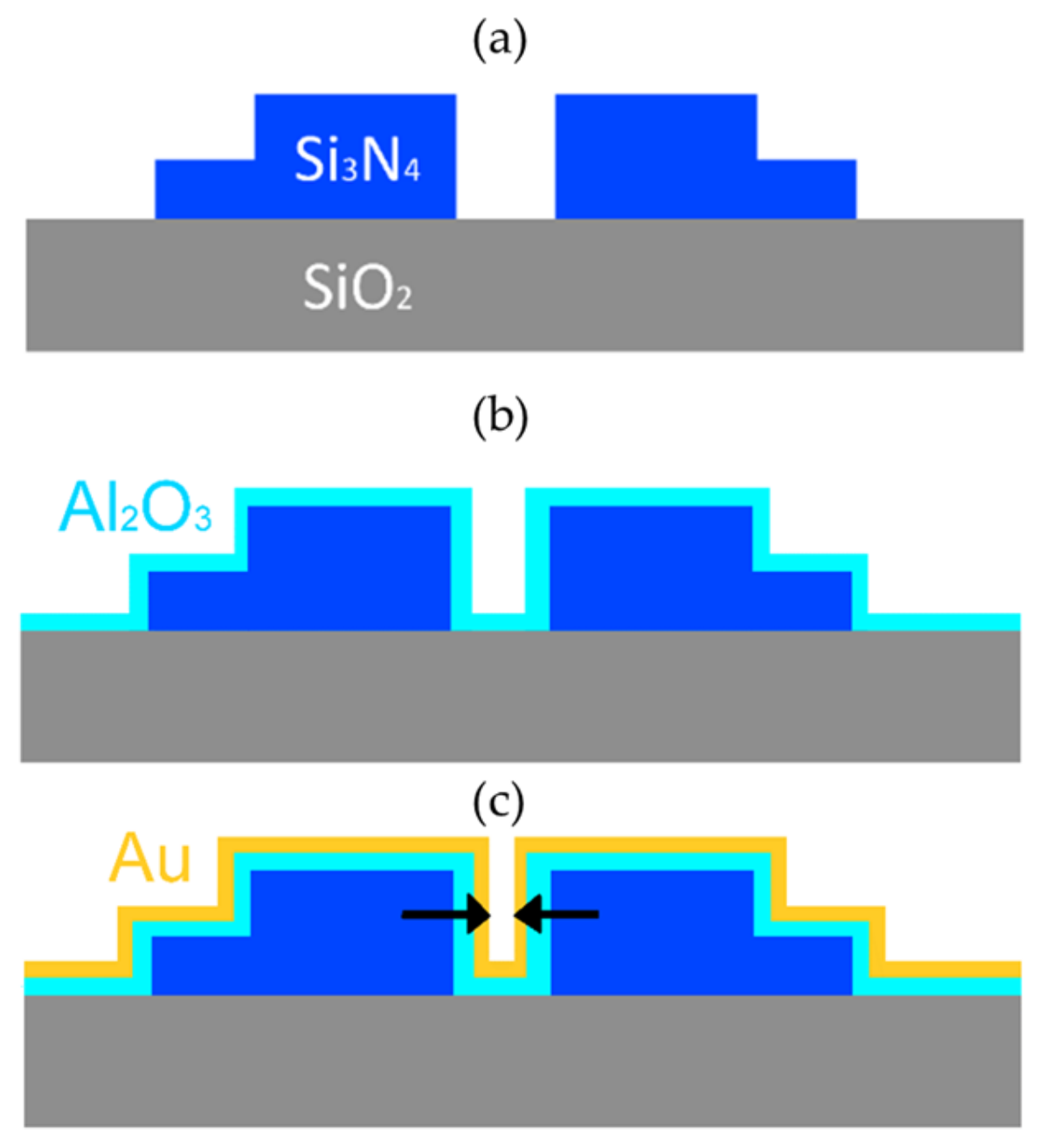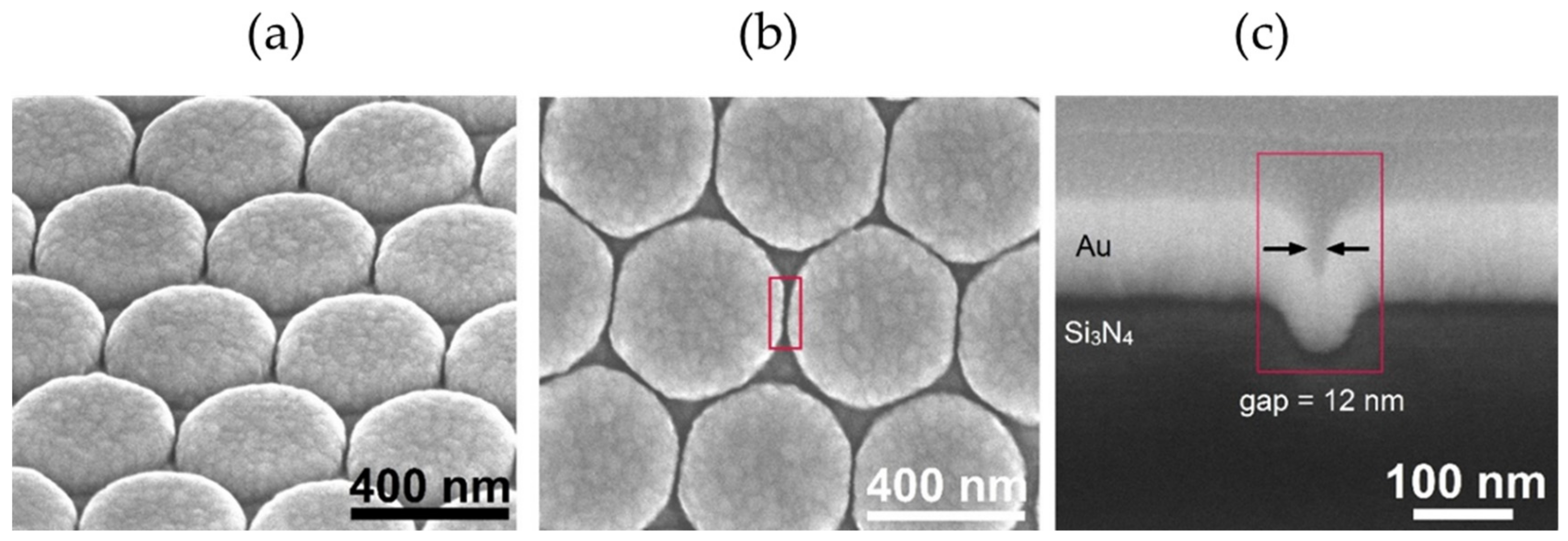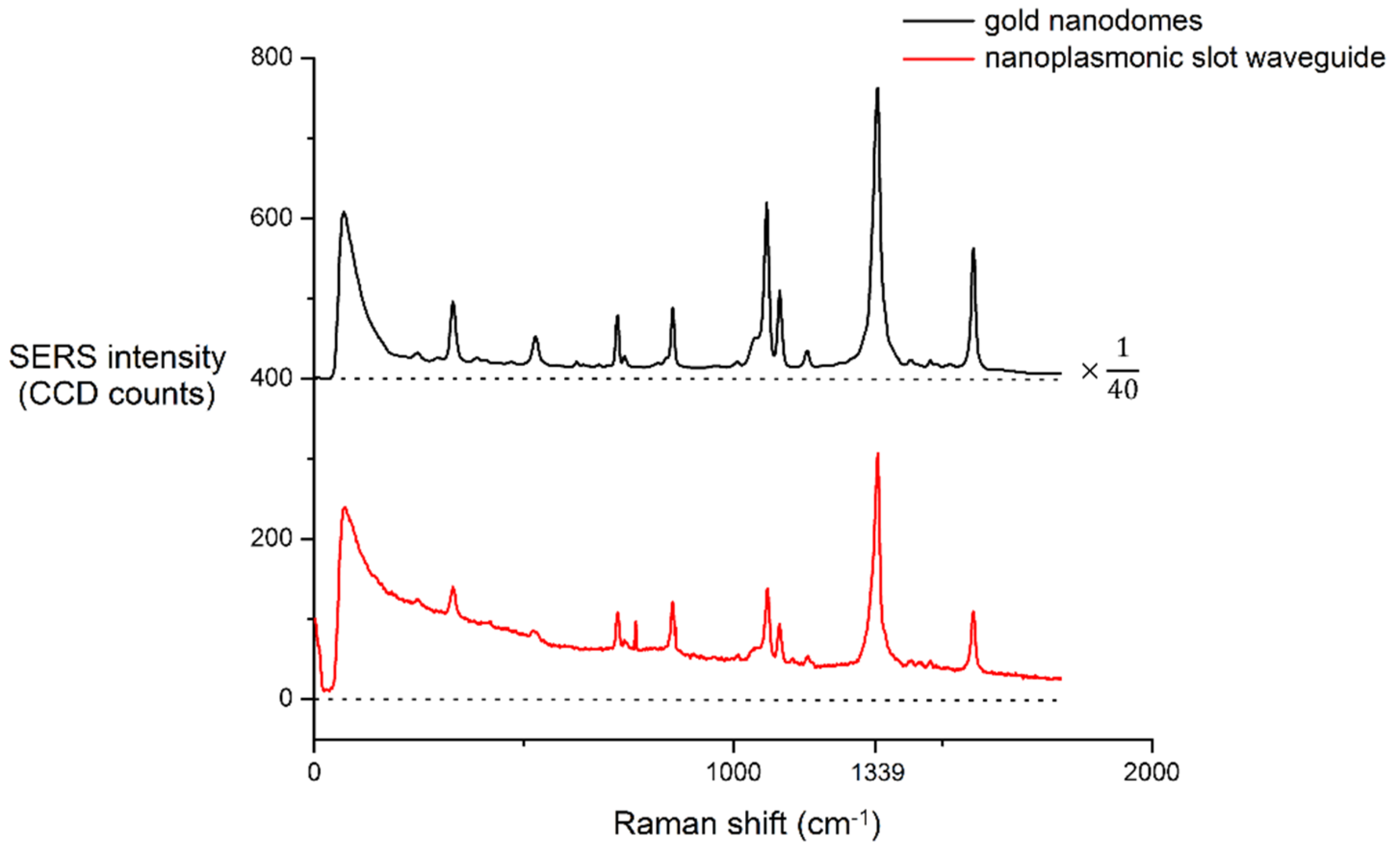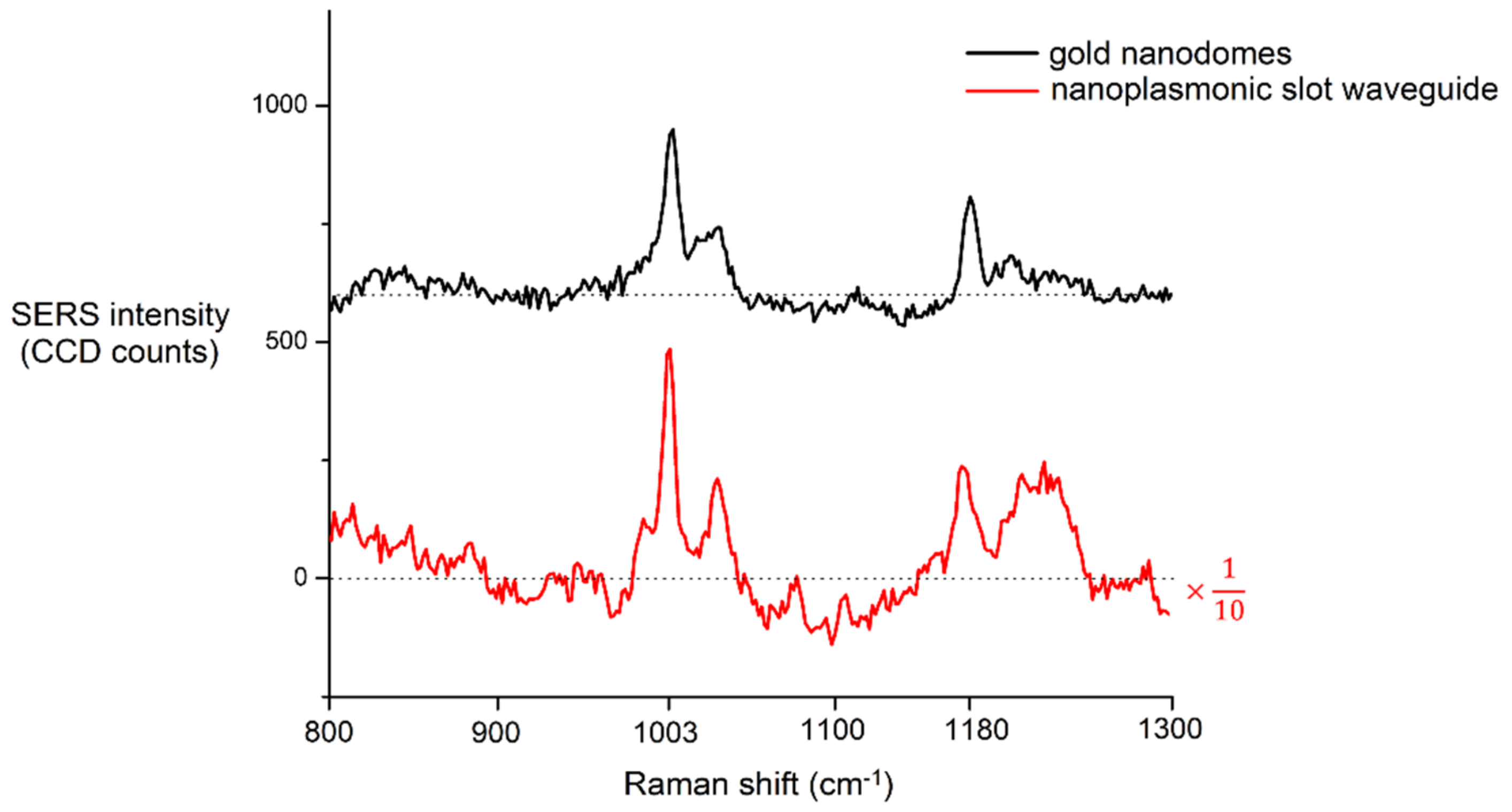Comparison of Free-Space and Waveguide-Based SERS Platforms
Abstract
1. Introduction
2. Materials and Methods
2.1. Fabrication of SERS Substrates
2.2. Acquisition of SERS Spectra of P-Nitrothiophenol
2.3. Acquisition of SERS Spectra of a Peptide
3. Results and Discussion
3.1. Comparison of Free-Space Excited Gold Nanodomes and Waveguide-Based Nanoplasmonic Slot Waveguide
3.1.1. Scalability of the Fabrication Processes
3.1.2. SERS Performance Comparison
3.2. SERS Detection of a Peptide on a Waveguide-Based Platform
4. Conclusions
Author Contributions
Funding
Acknowledgments
Conflicts of Interest
References
- Yampolsky, S.; Fishman, D.A.; Dey, S.; Hulkko, E.; Banik, M.; Potma, E.O.; Apkarian, V.A. Seeing a single molecule vibrate through time-resolved coherent anti-Stokes Raman scattering. Nat. Photonics 2014, 8, 650–656. [Google Scholar] [CrossRef]
- Anker, J.N.; Hall, W.P.; Lyandres, O.; Shah, N.C.; Zhao, J.; Van Duyne, R.P. Biosensing with plasmonic nanosensors. Nat. Mater. 2008, 7, 442–453. [Google Scholar] [CrossRef]
- Willets, K.A.; Van Duyne, R.P. Localized surface plasmon resonance spectroscopy and sensing. Annu. Rev. Phys. Chem. 2007, 58, 267–297. [Google Scholar] [CrossRef] [PubMed]
- Halas, N.J.; Lal, S.; Chang, W.S.; Link, S.; Nordlander, P. Plasmons in strongly coupled metallic nanostructures. Chem. Rev. 2011, 111, 3913–3961. [Google Scholar] [CrossRef]
- Giannini, V.; Fernández-Domínguez, A.I.; Heck, S.C.; Maier, S.A. Plasmonic nanoantennas: Fundamentals and their use in controlling the radiative properties of nanoemitters. Chem. Rev. 2011, 111, 3888–3912. [Google Scholar] [CrossRef] [PubMed]
- Chu, Y.; Banaee, M.G.; Crozier, K.B. Double-resonance plasmon substrates for surface-enhanced Raman scattering with enhancement at excitation and Stokes frequencies. ACS Nano 2010, 4, 2804–2810. [Google Scholar] [CrossRef]
- Ye, J.; Wen, F.; Sobhani, H.; Lassiter, J.B.; Van Dorpe, P.; Nordlander, P.; Halas, N.J. Plasmonic nanoclusters: Near field properties of the fano resonance interrogated with SERS. Nano Lett. 2012, 12, 1660–1667. [Google Scholar] [CrossRef] [PubMed]
- Bontempi, N.; Carletti, L.; De Angelis, C.; Alessandri, I. Plasmon-free SERS detection of environmental CO2 on TiO2 surfaces. Nanoscale 2016, 8, 3226–3231. [Google Scholar] [CrossRef] [PubMed]
- Gallinet, B.; Siegfried, T.; Sigg, H.; Nordlander, P.; Martin, O.J.F. Plasmonic radiance: Probing structure at the Angström scale with visible light. Nano Lett. 2013, 13, 497–503. [Google Scholar] [CrossRef] [PubMed]
- Siegfried, T.; Ekinci, Y.; Martin, O.J.F.; Sigg, H. Gap plasmons and near-field enhancement in closely packed sub-10 nm gap resonators. Nano Lett. 2013, 13, 5449–5453. [Google Scholar] [CrossRef] [PubMed]
- Li, J.; Chen, C.; Jans, H.; Xu, X.; Verellen, N.; Vos, I.; Okumura, Y.; Moshchalkov, V.V.; Lagae, L.; Van Dorpe, P. 300 mm Wafer-level, ultra-dense arrays of Au-capped nanopillars with sub-10 nm gaps as reliable SERS substrates. Nanoscale 2014, 6, 12391–12396. [Google Scholar] [CrossRef] [PubMed]
- Seok, T.J.; Jamshidi, A.; Eggleston, M.; Wu, M.C. Mass-producible and efficient optical antennas with CMOS-fabricated nanometer-scale gap. Opt. Express 2013, 21, 16561–16569. [Google Scholar] [CrossRef] [PubMed]
- Schlücker, S. Surface-enhanced Raman spectroscopy: Concepts and chemical applications. Angew. Chem. Int. Ed. Engl. 2014, 53, 4756–4795. [Google Scholar] [CrossRef]
- Wuytens, P.C.; Subramanian, A.Z.; De Vos, W.H.; Skirtach, A.G.; Baets, R. Gold nanodome-patterned microchips for intracellular surface-enhanced Raman spectroscopy. Analyst 2015, 140, 8080–8087. [Google Scholar] [CrossRef] [PubMed]
- Wuytens, P.C.; Demol, H.; Turk, N.; Gevaert, K.; Skirtach, A.G.; Lamkanfi, M.; Baets, R. Gold nanodome SERS platform for label-free detection of protease activity. Faraday Discuss. 2017, 205, 345–361. [Google Scholar] [CrossRef]
- Otto, A.; Mrozek, I.; Grabhorn, H.; Akemann, W. Surface-enhanced Raman scattering. J. Phys. Condens. Matter 1992, 4, 1143. [Google Scholar] [CrossRef]
- Moskovits, M. Surface-enhanced spectroscopy. Rev. Mod. Phys. 1985, 57, 783. [Google Scholar] [CrossRef]
- Itah, T.; Yamamoto, Y.S. Why and how do the shapes of surface-enhanced Raman scattering spectra change? Recent progress from mechanistic studies. J. Raman Spectrosc. 2015, 47, 77–88. [Google Scholar] [CrossRef]
- Yamamoto, Y.S.; Ozaki, Y.; Itoh, T. Recent progress and frontiers in the electromagnetic mechanism of surface-enhanced Raman scattering. J. Photochem. Photobiol. 2014, 21, 81–104. [Google Scholar] [CrossRef]
- Mosier-Boss, P.A. Review of SERS Substrates for Chemical Sensing. Nanomaterials 2017, 7, 142. [Google Scholar] [CrossRef]
- Hulteen, J.C.; Van Duyne, R.P. Nanosphere lithography: A materials general fabrication process for periodic particle array surfaces. J. Vac. Sci. Technol. 1995, 13, 1553. [Google Scholar] [CrossRef]
- Stuart, D.A.; Yonzon, C.R.; Zhang, X.; Lyandres, O.; Shah, N.C.; Glucksberg, M.R.; Walsh, J.T.; Van Duyne, R.P. Glucose Sensing Using Near-Infrared Surface-Enhanced Raman Spectroscopy: Gold Surfaces, 10-Day Stability, and Improved Accuracy. Anal. Chem. 2005, 77, 13–4013. [Google Scholar] [CrossRef] [PubMed]
- Farcau, C.; Astilean, S. Mapping the SERS Efficiency and Hot-Spots Localization on Gold Film over Nanospheres Substrates. J. Phys. Chem. C 2010, 114, 11717–11722. [Google Scholar] [CrossRef]
- Tabatabaei, M.; Sangar, A.; Kazemi-Zanjani, N.; Torchio, P.; Merlen, A.; Lagugné-Labarthet, F. Optical Properties of Silver and Gold Tetrahedral Nanopyramid Arrays Prepared by Nanosphere Lithography. J. Phys. Chem. C 2013, 117, 14778–14786. [Google Scholar] [CrossRef]
- Huebner, U.; Weber, K.; Cialla, D.; Haehle, R.; Schneidewind, H.; Zeisberger, M.; Mattheis, R.; Meyer, H.G.; Popp, J. Microfabricated polymer-substrates for SERS. Microelectron. Eng. 2012, 98, 444–447. [Google Scholar] [CrossRef]
- Peyskens, F.; Subramanian, A.Z.; Neutens, P.; Dhakal, A.; Van Dorpe, P.; Le Thomas, N.; Baets, R. Bright and dark plasmon resonances of nanoplasmonic antennas evanescently coupled with a silicon nitride waveguide. Opt. Express 2015, 23, 3088–3101. [Google Scholar] [CrossRef]
- Benabid, F.; Knight, J.C.; Antonopoulos, G.; Russell, P.S.J. Stimulated Raman scattering in hydrogen-filled hollow-core photonic crystal fiber. Science 2002, 298, 399–402. [Google Scholar] [CrossRef]
- Dhakal, A.; Subramanian, A.Z.; Wuytens, P.; Peyskens, F.; Le Thomas, N.; Baets, R. Evanescent excitation and collection of spontaneous Raman spectra using silicon nitride nanophotonic waveguides. Opt. Lett. 2014, 39, 4025–4028. [Google Scholar] [CrossRef]
- Boerkamp, M.; van Leest, T.; Heldens, J.; Leinse, A.; Hoekman, M.; Heideman, R.; Caro, J. On-chip optical trapping and Raman spectroscopy using a TripleX dual-waveguide trap. Opt. Express 2014, 22, 30528–30537. [Google Scholar] [CrossRef]
- Holmstrom, S.A.; Stievater, T.H.; Kozak, D.A.; Pruessner, M.W.; Tyndall, N.; Rabinovich, W.S.; McGill, R.A.; Khurgin, J.B. Trace-gas raman spectroscopy using functionalized waveguides. Optica 2016, 3, 891–896. [Google Scholar] [CrossRef]
- Evans, C.C.; Liu, C.; Suntivich, J. TiO2 Nanophotonic sensors for efficient integrated evanescent Raman spectroscopy. ACS Photonics 2016, 3, 1662–1669. [Google Scholar] [CrossRef]
- Measor, P.; Seballos, L.; Yin, D.; Zhang, J.Z. On-chip surface-enhanced Raman scattering detection using integrated liquid-core waveguides. Appl. Phys. Lett. 2007, 90, 211107. [Google Scholar] [CrossRef]
- Lin, S.; Zhu, W.; Jin, Y.; Crozier, K.B. Surface-Enhanced Raman Scattering with Ag Nanoparticles Optically Trapped by a Photonic Crystal Cavity. Nano Lett. 2013, 13, 559–563. [Google Scholar] [CrossRef] [PubMed]
- Kong, L.; Lee, C.; Earhart, C.M.; Cordovez, B.; Chan, J.W. A nanotweezer system for evanescent wave excited surface enhanced Raman spectroscopy (SERS) of single nanoparticles. Opt. Express 2015, 23, 6793–6802. [Google Scholar] [CrossRef] [PubMed]
- Peyskens, F.; Dhakal, A.; Van Dorpe, P.; Le Thomas, N.; Baets, R. Surface Enhanced Raman Spectroscopy Using a Single Mode Nanophotonic-Plasmonic Platform. ACS Photonics 2016, 3, 102–108. [Google Scholar] [CrossRef]
- Peyskens, F.; Wuytens, P.; Raza, A.; Van Dorpe, P.; Baets, R. Waveguide excitation and collection of surface-enhanced Raman scattering from a single plasmonic antenna. Nanophotonics 2018, 7, 1299–1306. [Google Scholar] [CrossRef]
- Wuytens, P.C.; Skirtach, A.G.; Baets, R. On-chip surface-enhanced Raman spectroscopy using nanosphere-lithography patterned antennas on silicon nitride waveguides. Opt. Express 2017, 25, 12926–12934. [Google Scholar] [CrossRef] [PubMed]
- Raza, A.; Clemmen, S.; Wuytens, P.; Muneeb, M.; Van Daele, M.; Dendooven, J.; Detavernier, C.; Skirtach, A.; Baets, R. ALD assisted nanoplasmonic slot waveguide for on-chip enhanced Raman spectroscopy. APL Photonics 2018, 3, 116105. [Google Scholar] [CrossRef]
- Tang, F.; Adam, P.M.; Boutami, S. Theoretical investigation of SERS nanosensors based on hybrid waveguides made of metallic slots and dielectric strips. Opt. Express 2016, 24, 21244–21255. [Google Scholar] [CrossRef] [PubMed]
- Li, S.; Xia, L.; Chen, X.; Yang, Z.; Li, W. Surface-enhanced Raman scattering sensor based on hybrid deep slot waveguide on an integrated photonic platform. J. Opt. Soc. Am. B 2019, 36, 2423–2428. [Google Scholar] [CrossRef]
- Wong, H.M.K.; Dezfouli, M.K.; Sun, L.; Hughes, S.; Helmy, A.S. Nanoscale plasmonic slot waveguides for enhanced Raman spectroscopy. Phys. Rev. B 2018, 98, 085124. [Google Scholar] [CrossRef]
- Cao, Q.; Feng, J.; Lu, H.; Zhang, H.; Zhang, F.; Zhang, H. Surface-enhanced Raman scattering using nanoporous gold on suspended silicon nitride waveguides. Opt. Express 2018, 26, 24614–24620. [Google Scholar] [CrossRef] [PubMed]
- Raza, A.; Clemmen, S.; Wuytens, P.; de Goede, M.; Tong, A.S.K.; Le Thomas, N.; Liu, C.; Suntivich, J.; Skirtach, A.G.; Garcia-Blanco, S.M.; et al. High index contrast photonic platforms for on-chip Raman spectroscopy. Opt. Express 2019, 27, 23067–23079. [Google Scholar] [CrossRef] [PubMed]
- Jun, Y.C.; Kekatpure, R.D.; White, J.S.; Brongersma, M.L. Nonresonant enhancement of spontaneous emission in metal-dielectric-metal plasmon waveguide structures. Phys. Rev. B 2008, 78, 153111. [Google Scholar] [CrossRef]
- Du, P.; Zhang, X.; Yin, H.; Zhao, Y.; Liu, L.; Wu, Z.; Xu, H. In situ surface-enhanced Raman scattering monitoring of reduction of 4-nitrothiophenol on bifunctional metallic nanostructure. Jpn. J. Appl. Phys. 2018, 57, 030308. [Google Scholar] [CrossRef]
- Mahajan, S.; Cole, R.M.; Speed, J.D.; Pelfrey, S.H.; Russell, A.E.; Bartlett, P.N.; Barnett, S.M.; Baumberg, J.J. Understanding the Surface-Enhanced Raman Spectroscopy “Background”. J. Phys. Chem. C 2009, 114, 7242–7250. [Google Scholar] [CrossRef]
- Barnett, S.M.; Harris, N.; Baumberg, J.J. Molecules in the mirror: How SERS backgrounds arise from the quantum method of images. Phys. Chem. Chem. Phys. 2014, 16, 6544–6549. [Google Scholar] [CrossRef]
- Hugall, J.T.; Baumberg, J.J. Demonstrating Photoluminescence from Au is Electronic Inelastic Light Scattering of a Plasmonic Metal: The Origin of SERS Backgrounds. Nano Lett. 2015, 15, 2600–2604. [Google Scholar] [CrossRef]
- Ikeda, K.; Suzuki, S.; Uosaki, K. Enhancement of SERS Background through Charge Transfer Resonances on Single Crystal Gold Surfaces of Various Orientations. J. Am. Chem. Soc. 2013, 135, 17387–17392. [Google Scholar] [CrossRef]
- Liu, Z.; Zhao, H.; Raza, A.; Le Thomas, N.; Baets, R. On the Performance of Tantalum Pentoxide and Silicon Nitride Slot Waveguides for On-Chip Raman Spectroscopy. In Proceedings of the European Conference on Integrated Optics, Ghent, Belgium, 24–26 April 2019. [Google Scholar]
- Drag, M.; Salvesen, G.S. Emerging principles in protease-based drug discovery. Nat. Rev. Drug Discov. 2019, 9, 690–701. [Google Scholar] [CrossRef]
- De Gelder, J.; De Gussem, K.; Vandenabeele, P.; Moens, L. Reference database of Raman spectra of biological molecules. J. Raman Spectrosc. 2007, 38, 1133–1147. [Google Scholar] [CrossRef]








| SERS Platform | SBR | SNR (Pin = 1 mW, t = 1 s) |
|---|---|---|
| Gold nanodomes (FS) | 3.28 | 3 × 104 |
| Integrated bowties (WG) | 0.12 | 102 |
| Integrated nanotriangles (WG) | 0.72 | 103 |
| Nanoplasmonic slot waveguide (WG) | 1.16 | 2 × 103 |
© 2019 by the authors. Licensee MDPI, Basel, Switzerland. This article is an open access article distributed under the terms and conditions of the Creative Commons Attribution (CC BY) license (http://creativecommons.org/licenses/by/4.0/).
Share and Cite
Turk, N.; Raza, A.; Wuytens, P.; Demol, H.; Van Daele, M.; Detavernier, C.; Skirtach, A.; Gevaert, K.; Baets, R. Comparison of Free-Space and Waveguide-Based SERS Platforms. Nanomaterials 2019, 9, 1401. https://doi.org/10.3390/nano9101401
Turk N, Raza A, Wuytens P, Demol H, Van Daele M, Detavernier C, Skirtach A, Gevaert K, Baets R. Comparison of Free-Space and Waveguide-Based SERS Platforms. Nanomaterials. 2019; 9(10):1401. https://doi.org/10.3390/nano9101401
Chicago/Turabian StyleTurk, Nina, Ali Raza, Pieter Wuytens, Hans Demol, Michiel Van Daele, Christophe Detavernier, Andre Skirtach, Kris Gevaert, and Roel Baets. 2019. "Comparison of Free-Space and Waveguide-Based SERS Platforms" Nanomaterials 9, no. 10: 1401. https://doi.org/10.3390/nano9101401
APA StyleTurk, N., Raza, A., Wuytens, P., Demol, H., Van Daele, M., Detavernier, C., Skirtach, A., Gevaert, K., & Baets, R. (2019). Comparison of Free-Space and Waveguide-Based SERS Platforms. Nanomaterials, 9(10), 1401. https://doi.org/10.3390/nano9101401








